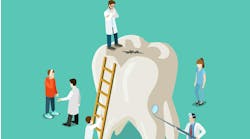Part Three of a three-part series
Taking patient impressions is one of the most cumbersome tasks a dental professional performs. Goopy and error-prone, the process is annoying to patients and practice staff alike. Fortunately, technology is improving this activity and streamlining the workflow for doctors in many specialties, including general practitioners, orthodontists, and oral surgeons.
In the last of my three-part series on going digital, I would like to focus on the advanced level of implementing CAD/CAM into your practice-more specifically, the role that digital impressions can play in your workflow. Intraoral scanners are becoming more prevalent in the dental industry, and for good reason-they reduce the costs associated with conventional impression consumables and can fabricate anything from restorations and implants to orthodontic appliances and mouthguards.
Much has been said about the patient benefits of switching from conventional to digital impressions, but there are also a number of unexpected benefits to the practitioner. In addition to providing the tools necessary to design your own restorations (or even mill in-house), digital impressions have distinct advantages when it comes to improving tooth preparation or expediting the fabrication process.
Improved tooth preparation
With digital impressions, you can dramatically enlarge the 3-D image in order to better visualize the tooth preparation. The magnification is significantly larger than anything you can get by using loupes. In addition, you can rotate the image to see all aspects of the preparation design-something that is impossible in the mouth. These key advantages provide guidance for better design and more accurate margin preparation, directly improving form, fit, and function of the final restoration.
Another huge benefit of digital impressions is the amount of information captured. Because of their high accuracy and improved occlusal and contact area design, they ensure an easier and faster delivery of the final restoration.
Not only that, but today's true-color scanners allow users to clearly distinguish tooth structures from soft tissue and restorations. Advanced software tools also help users identify margin lines, contact points, and undercuts for improved visualization. When combined, all of these features result in improved preparation and restoration delivery.
Faster fabrication
In addition to facilitating tooth preparation and eliminating the potential for errors associated with conventional impressions, digital impressions also improve the fabrication process. When capturing the digital impression, the scanner will tell you whether or not the capture was successful. If you are missing any information, you can correct this during the same appointment instead of asking the patient to return for another impression. Additionally, you can reduce the chance of getting a call from the lab saying there was an error with the impression capture, which would also require you to bring the patient back to the office. The time and cost of setting up and cleaning an operatory for an additional appointment reduces your bottom line, while also creating a dissatisfied patient who has to take additional time off from work.
The 3-D models don't have to be shipped to the lab, which means that the quicker data transmission results in a quicker turnaround for delivering the final restoration. This also eliminates any potential damage caused to the model during shipping.
Faster fabrication also has a significant impact on your patient care. Because the temporary restoration is in the patient's mouth for a shorter period of time, you can decrease the need for emergency visits caused by a lost temporary.
The takeaway
Incorporating digital technology into a practice can happen in several ways, including transitioning from analog to digital processes, bringing 3-D imaging in-house, and implementing the ability to design and fabricate appliances. While not every method is practical for every practice, the truth is that technology not only has the ability to streamline your workflow by improving diagnostic and treatment-planning capabilities, but can also improve the patient experience.
Edward Shellard, DMD, has more than two decades of clinical and executive experience in the dental industry. Since joining Carestream Dental in 2008, Dr. Shellard has driven global marketing strategy and product development efforts for the latest innovations in dental and practice-management technology.





